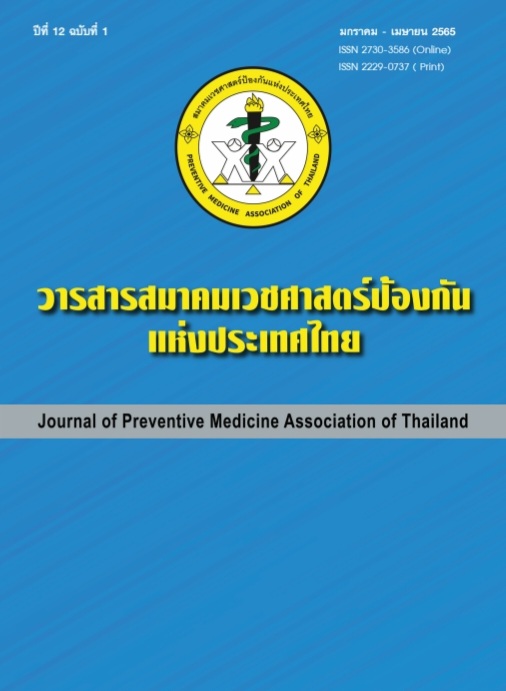Development of Nursing Model for Sepsis Patients
Keywords:
development of nursing model, evidence-based, sepsis patients, septic shockAbstract
Objective: Is to develop nursing model and study the outcomes of nursing model for sepsis patients implementation.
Design: Research and Development
Methodology: The samples were 1) 35 professional nurses, 2) 70 patients with sepsis, 3) 16 persons of multidisciplinary teams. Research methods were divided into 3 phases: Phases I was situational study, Phase 2 was developed nursing model for sepsis patients, Phase 3 was an assessment by using the nursing model. This research was implemented during January-November 2020. Research instruments were 1. research method instruments: a nursing model for sepsis patients, medical record audit form, in-depth interview form. 2. collecting data instruments: nursing knowledge and nurses competency assessment form, questionnaire of nurses’ satisfaction, clinical outcome record form. Data analysis were used by content analysis, descriptive statistics and Paired T-Test.
Results:1.The nursing model for sepsis patients that was developed, consisted of 1) knowledge, practice of patients competency 2) clinical nursing practice guideline of sepsis patients by evidence-based 3) instrument of screening, diagnostic, clinical practice guideline 4) multidisciplinary teams work 2.The results after using the nursing model showed that: 1) knowledge of professional nurses mean scoreswere significantly increased (p=0.001) 2) competency of professional nurses were increased from good level to excellent 3) satisfaction of professional nurses for using nursing model were at the highest level. The main clinical outcomes were a higher rate of sepsis diagnosis, and rapidly transfer to treatment before shock, septic shock, and mortality rates were reduced.
Recommendation: nursing model for sepsis patients should be expanded in another hospital to improved clinical outcomes.
References
Petchborom P. Sepsis: from evidence moving towards technologies. In: Sataworn D, Piyavejwirat K, Punyathaworn S, editors. The Best ICU. Bangkok: Thai Association of Critical Care Medicine; 2017. P. 231-40. (in Thai)
Bentley J, Henderson S, Thakore S. Donald M, Wang W. Seeking sepsis in the emergency department-identifying barriers to delivery of the sepsis 6. BMJ Qual Improv Rep 2016;5(1):1-6.
Levy MM, Evans LE, Rhodes A. The surviving sepsis campaign bundle: 2018 update. Intensive Care Med 2018;44(6):925–8.
Epstein L, Dantes R, Magill S, Fiore A. Varying estimates of sepsis mortality using death certificates and administrative codes-United States, 1999-2014. MMWR Morb Mortal Wkly Rep 2016;65:342-5.
Mc Clelland H, Moxon A. Early identification and treatment of sepsis. Nurs Times 2014;110(4):14-7.
Spiegel R, Farkas JD, Rola P, Kenny JE, Olusanya S, Marik PE, et al. The 2018 surviving sepsis campaign's treatment bundle: when guidelines outpace the evidence supporting their use. Ann Emerg Med 2019;73(4):356-58.
National Antimicrobial Resistance Surveillance Center. Antibiotic-resistant bacteria[Internet]. [cited 2017 Jan 12]. Available from:http://narst.dmsc.moph.go.th/news001.html
Wirotwanit N. The effectiveness of implementing the nurse practice guideline among patients with sepsis at emergency department, Naresuan University Hospital. Journal of Nursing and Health Sciences 2561;12(1):84-93. (in Thai)
Levy MM, Dellinger RP, Townsend SR, Linde-Zwirble WT, Marshall JC, Bion J, et al. The surviving sepsis campaign: results of an international guideline-based performance improvement program targeting severe sepsis. Crit Care Med 2010; 38(2): 367-74.
McColl T, Gatien M, Calder L, Yadav K, Tam R, Ong M, et al. Implementation of an emergencydepartment sepsis bundle and system redesign: a process improvement initiative. Can J Emerg Med 2017;19(2):112-21.
Soukup SM. The center for advanced nursing practice evidence-based practice model: promoting the scholarship of practice. Nurs Clin North Am 2000;35(2):301-9.
Wongkhan K. Innovative research model (R&D, D&D, AR, R2R) Training program create a new generation of researchers (5th generation) [Internet]. 2017 [cited 2018 Jan 12]. Available from:fromkitt w_2000@yahoo.ie.
Srisatidnarakul B. The methodology in nursing research. 3rd ed. Bangkok: You and I Inter Media; 2007.
Rodjinda S, Puttapitukpol S, Phuangkhem W. Development of caring model for sepsis patients in the medical wards, Nan Hospital. Nursing Journal of the Ministry of Public Health 2020;30(1):120-34. (in Thai)
Thumneumoin S. Development of nursing care for sepsis patients, The office of disease prevention and control 2018;16(2):58-68. (in Thai)
Rungthanakiat P, Promtuang S, Paengbuddee Ch. Development of the Care Model for Patients with Septicemia using Fast Track System at Surin Hospital. Thai Journal of Nursing and Midwifery Practice 2019; 6(1):36-51. (in Thai)
Noparith P, Traiyawong S, Koteprom J. A development of nursing care model for sepsis patients in Mukdahan Hospital. Journal of Nursing and Health Care 2019; 37(1):221-30. (in Thai)
Waranung T. Outcomes of using the clinical practice guideline for patients with sepsis at Fang hospital, Chiangmai Province. Chiangrai Medical Journal 2019;11(1):1-8. (in Thai)
Mahantassanapong Ch. Outcome of the Surin Sepsis Treatment Protocol in Sepsis Management. Srinagarind Medical Journal 2012;27(4) :332-9. (in Thai)
Amphon K, Bunyoprakarn C, Sinkincharoen P. The Outcomes of the Development of the Patients with Septicemia, Prapokklao Hospital. J Prapokklao Hosp Clin Med Educat Center. 2017;34(3):222-6. (in Thai)
Downloads
Published
How to Cite
Issue
Section
License
Copyright (c) 2022 Journal of Preventive Medicine Association of Thailand

This work is licensed under a Creative Commons Attribution-NonCommercial-NoDerivatives 4.0 International License.
บทความที่ลงพิมพ์ในวารสารเวชศาสตร์ป้องกันแห่งประเทศไทย ถือเป็นผลงานวิชาการ งานวิจัย วิเคราะห์ วิจารณ์ เป็นความเห็นส่วนตัวของผู้นิพนธ์ กองบรรณาธิการไม่จำเป็นต้องเห็นด้วยเสมอไปและผู้นิพนธ์จะต้องรับผิดชอบต่อบทความของตนเอง






